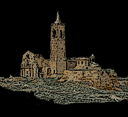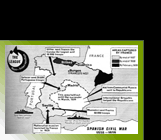| 13th December 1936 - 15th January 1937 |
THE BATTLE FOR THE
CORUNNA ROAD
As the frontal attack upon Madrid had failed, the Nationalists
now tried to tighten the siege and to cut off the capital
from the rest of Republican Spain. On 13th December General
Jose Varela launched an offensive towards the Corunna Road,
which runs 25 miles to the North of Madrid. Between 3rd and
15th January his forces held a 7 mile stretch of the road
against fierce attacks by Republican troops but, as casualties
mounted on both sides, it became apparent that the situation
had become a stalemate.
|
| 17th January - 6th February 1937 |
THE BATTLE FOR MALAGA
With the arrival in Spain of the Italian "volunteers"
the Nationalists now felt able to mount an offensive on the
southern provinces of Republican Spain. Three Nationalist
columns converged on Malaga; the Army of the South, led by
General Gonzalo Quiepo de Llano, advanced from the West; from
Granada, to the north-east of the city, came forces under
the command of Colonel Antonio Munoz; and moving down from
the North were the Italians, led by General Mario Roatta.
Although large numbers of Republican troops were available
to defend Malaga, they were badly organised and they steadily
retreated. By 3rd February the attackers had reached the outskirts
of the city and, three days later, when the last defenders
fled northward towards Almeria, the Nationalists entered Malaga. |
| 6th - 24th February 1937 |
THE BATTLE OF JARAMA
The Nationalists renewed their attempts to capture Madrid.
This time they concentrated their efforts upon cutting the
Valencia Road where it runs through the Jarama Valley to the
south-east of the city. The Nationalists, under the leadership
of General Luis Orgaz, began their assault on 6th February
and, by 11th February, they had driven the Republican army,
commanded by General Sebastian Pozas, eastwards across the
River Jarama. To restore the situation General Jose Miaja
took over personal command of the dispirited Republican troops
on 15th February. By 24th February, when the fighting finally
ended, the Nationalists had driven a salient into the Republican
front-line but had failed again to cut Madrid off from the
rest of the Republic. |
| 8th - 18th March 1937 |
THE BATTLE OF GUADALAJARA
The Nationalist forces threatening Madrid were ordered to
attack around the north-east of the city in an attempt to
cut it off from the rest of the Republic. Two Nationalist
armies advanced towards Guadalajara, which is 34 miles from
Madrid, and pushed back the inexperienced Republican troops
that faced them. The right-hand (or western) army, which was
commanded by General Jose Moscardo, had little trouble in
forcing the opposing Republican troops back, but the left-hand
(or eastern) army, which was composed of Italian "volunteers"
and led by General Mario Roatta, experienced stiffening resistance
after their capture of Brihuega on 10th March. General Roatta
halted his advance on 15th March to re-group and the Republicans
used this break in the battle to mount a counter-attack. Two
divisions, assisted by Soviet tanks and aircraft and led
by Colonel Enrique Jurado, fell on the leading Italian units
on 18th March. The ferocity of the counter-attack surprised
the Italians and their retreat rapidly became a rout. Moscardo's
army was forced to fall back because of the Italian collapse
and the Republic recaptured Brihuega. Although the Nationalist
attack had gained some ground when the battle finally ended,
it had failed to achieve the decisive result that had been
hoped for. |
| 31st March - 19th June 1937 |
THE BATTLE FOR BILBAO
The Nationalists forces in the North, led by General Emilio
Mola, began an offensive against Basque forces in Vizcaya
with the intention of capturing the Basque stronghold of Bilbao.
The Basques, who were not well armed and who were led by General
Francisco Llano de la Encomienda, gave ground, and the towns
of Durango and Guernica surrendered on 28th April after suffering
heavy bombing by units of the German Condor Legion. After
the death of General Mola in an air crash on 3rd June, General
Fidel Davila took command of the Nationalist forces. By 11th
June the Basques had withdrawn behind the "Ring of Iron"
defences around Bilbao, but these proved to be less than effective
when subjected to heavy artillery bombardment. Under cover
of the bombardment the Nationalists breached the outer defences
and the "Ring of Iron" collapsed. On the night of
13th June most of the civilian inhabitants of Bilbao were
evacuated, and on 18th June the last units of the Basque army,
now led by General Mariano Gamir Ulibarri, abandoned the city.
The Nationalists entered Bilbao on the next day. |
| 19th April 1937 |
The Falange and Carlists Movement were united and became the
FET (Falange Espanola Tradicionalista y de las Junta de Ofensiva
Nacional-Sindicalista). |
| 23rd April 1937 |
The Madrid Defence Junta was dissolved. |
| 30th April 1937 |
During the blockade of Bilbao, the Nationalist battleship
Espana hit a mine and sank off Cape Penas near Santander. |
| 3rd - 8th May 1937 |
Street-fighting broke out in Barcelona; the CNT (Confederacion
Nacional de Trabajo [the Anarcho-Syndicalist Trades Union])
and POUM battled with the Communists supported by the Generalitat. |
| 7th May 1937 |
The Nationalist motor torpedo boat Javier Quiroga sank off
Gibraltar. |
| 15th May 1937 |
Largo Caballero resigned as Prime Minister. |
| 17th May 1937 |
After the resignation of Largo Caballero, Dr Juan Negrin (a
Socialist) became Prime Minister. The new Government was dominated
by Communists. |
| 31st May 1937 |
The Republicans began an offensive to
capture Segovia. Three Republican Divisions, under the command
of General Domingo Moriones, broke through the Nationalist front-line
at San Ildefonso and captured La Granja. Nationalist troops,
led by General Jose Varela, were detached from the Madrid front
and used to mount a counter-attack that stopped any further
Republican advance. |
| 16th June 1937 |
The POUM was outlawed and its leaders were arrested. |
| 17th June 1937 |
The Republican battleship Jaime I blew up and sank at Cartagena. |
| 18th June 1937 |
The Nationalist motor torpedo boat Falange sank. |
| 21st June 1937 |
Andres Nin (leader of the POUM) was murdered by Soviet agents. |
| 6th - 26th July 1937 |
THE BATTLE OF BRUNETE
After the failure of the Nationalist attack upon Guadalajara
the Republican troops around Madrid went on to the offensive.
General Jose Miaja ordered two Republican Corps (led by Generals
Juan Modesto and Enrique Jurado) to advance southwards from
the El Escorial - Madrid road towards Brunete. This would
then cut off the Nationalist forces besieging Madrid from
the West. Their initial thrust captured Brunete and drove
a 5 mile salient into the Nationalist front-line. The Nationalist
armies, under the command of General Jose Varela, then rallied
and mounted a counter-attack that forced the Republicans almost
all the way back to their start line. |
| 10th August 1937 |
The Council of Aragon was dissolved by the Republican government. |
| 14th - 25th August 1937 |
THE BATTLE FOR SANTANDER
After capturing Bilbao, the Nationalist forces in the North
of Spain switched their offensive towards Santander. The Nationalists,
who were led by General Fidel Davila, advanced westwards through
the Cantabrian Mountains. Despite the large numbers of troops
General Mariano Gamir had under his command, Republican resistance
was weak. This weakness was due, in the main, to poor training
and a shortage of weapons. On 23rd August the Basque forces
in the Republican army surrendered to General Ettore Bastico,
and because further resistance was impossible, Ulibarri abandoned
his remaining troops and flew to safety in France. The Nationalists
were then able to enter Santander almost unopposed. |
| 15th August 1937 |
A new political police force, the SIM (Servicio Investigacion
Militar), was formed in Republican Spain. It was controlled
by the Communists and contained many Soviet "advisers" |
| 24th August - 30th September 1937 |
THE BATTLE FOR SARAGOSSA
The Republican Army of the East, led by General Sebastian
Pozas, advanced into Aragon from Catalonia to capture Saragossa.
They pushed back the Nationalist forces (which were commanded
by General Miguel Ponte) to the North and South of the River
Ebro, but were unable to dislodge them from the area around
Saragossa or to capture Huesca (in the North) or Teruel (in
the South). By the end of September the offensive had ceased
to have any impetus and had come to a halt. |
| 1st September - 21st October 1937 |
THE BATTLE FOR GIJON
After the capture of Bilbao and Santander the only remaining
Republican stronghold in the North was Gijon and the surrounding
area. The Nationalists, who were led by Generals Antonio Aranda
and Jose Solchaga, launched an offensive through the Mountains
of Leon and along the coast from the East to capture Gijon.
Aranda's forces were unable to break through the mountain
passes, which were defended by Asturian troops, until a Navarrese
force, under Solchaga's command, captured the village of Infiesto.
This out-flanked the defences and the Asturians were forced
to retreat. On 21st October Gijon surrendered and the whole
northern coast of Spain now passed into Nationalist control. |
| 1st October 1937 |
Largo Caballero was removed from the leadership of the UGT
(Union General de Trabajadores [Socialist Trades Union]). |
| 20th October 1937 |
The Republican submarine C6 was scuttled at Gijon after suffering
damage during a Nationalist air attack. |
| 21st October 1937 |
The Republican destroyer Ciscar was sunk at Gijon by Nationalist
aircraft. |
| 31st November 1937 |
The Republican Government moved from Valencia to Barcelona. |
| 15th December 1937 - 20th February 1938 |
THE BATTLE OF TERUEL
The Republican Army launched an offensive to capture Teruel
to pre-empt a Nationalist attack upon Catalonia. Two Republican
armies (led by Generals Hernandez Sarabia and Leopoldo Menendez)
advanced on Teruel and by nightfall on 15th December they
had surrounded the city. The garrison, which was commanded
by Colonel Rey d'Harcourt, held out in the southern part of
the city until 8th January; casualties and lack of supplies
then forced them to surrender. On 29th December General Franco
had ordered Generals Jose Varela and Antonio Aranda to mount
a counter-attack to relieve the defenders but the appalling
winter weather hampered their advance and d'Harcourt had surrendered
before they could raise the siege. The Republicans now found
that they were in danger of being besieged in Teruel themselves.
On 7th February Nationalist cavalry attacked the Republican
forces to the North of the city and forced them to retreat
and by 17th February Moroccan troops (led by General Juan
Yague) had crossed the River Alfambra. Three days later the
Nationalists had almost surrounded the city and the Republican
armies were forced to retreat along the Valencia road to the
south-east. The Nationalists then reoccupied Teruel. |




